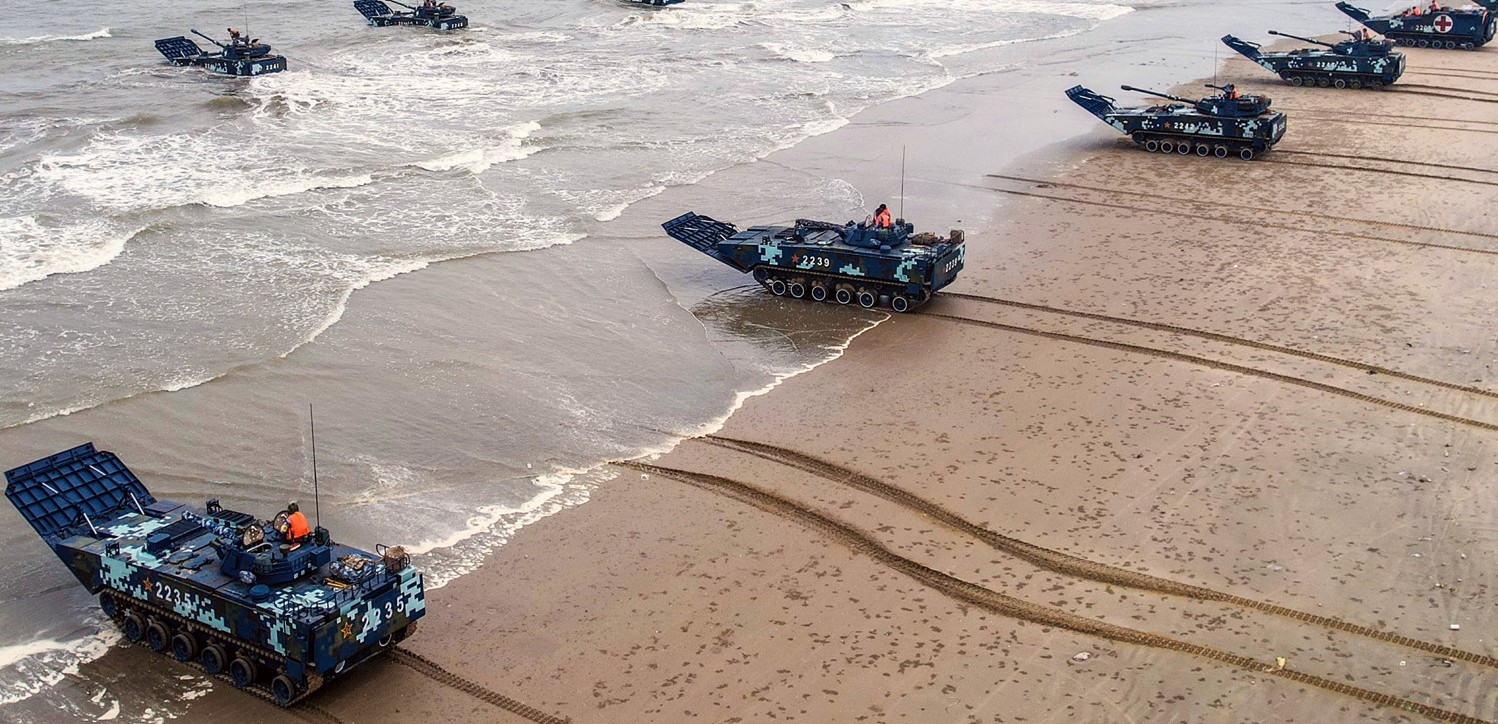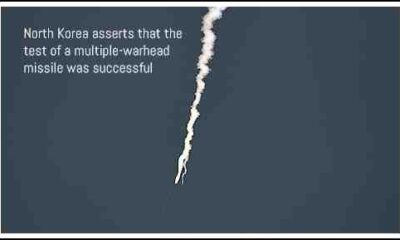Latest News
The US predicts that if China invades Taiwan, 10,000 PLA troops will be killed and 150 fighter jets will be shot down
Published
1 year agoon

A US think tank recently simulated a Chinese invasion of Taiwan in 2026 and published its findings on January 9, implying that a conflict over Taiwan would result in thousands of casualties among Chinese, US, Taiwanese, and Japanese forces and that China would almost certainly lose the war.
The Center for Strategic and International Studies (CSIS) in Washington, DC, ran wargame simulations of a possible conflict over Taiwan, which has alarmed military and political leaders in Asia and the United States.
According to the simulation results, at least two US aircraft carriers would be sunk in the Pacific at the end of the conflict, while China’s modernized People’s Liberation Army (PLA) Navy, the world’s largest naval force, would be in “shambles.”
Despite winning the war, the US military would be crippled in the same way that the defeated PLA forces were.
These are some of the conclusions reached by the CSIS after conducting one of the most extensive wargame simulations ever conducted on a possible war over Taiwan, the 24 million-person island nation that the Chinese Communist Party claims as part of its sovereign territory and intends to reunify with the Chinese mainland.
CSIS ran two dozen war scenarios, with the results published in a report titled ‘The First Battle of the Next War.’
Previous unclassified analyses either focus on one aspect of an invasion, are not rigorously structured, or do not focus on military operations, according to the leading American think tank, and classified wargames are not transparent to the public.
According to the CSIS report, without a suitable analysis, public debate will remain unanchored.
Read Also – Tamil Nadu or Tamizhagam? The Governor-DMK squabble was lost in translation
The CSIS War Game’s Findings
CSIS ran this wargame 24 times in order to answer two fundamental questions: would the invasion succeed, and if so, at what cost? According to the CSIS report, the likely answers to these two questions are no and enormous.
According to the results summarised at the start, “the invasion always starts the same way,” which includes an opening bombardment that destroys the majority of Taiwan’s navy and air force in the first hours of hostilities.
Bolstered by the powerful PLA Rocket Force (PLAF), the PLA Navy would encircle Taiwan and intercept and prevent any attempts to get ships and aircraft to the besieged island. Tens of thousands of Chinese soldiers would cross the strait in a combination of military amphibious craft and civilian roll-on, roll-off ships while air assault and airborne forces land behind the beachheads.
According to CSIS, in the most likely baseline scenario, the Chinese invasion would quickly falter as Taiwanese ground forces, despite massive Chinese bombardment, would stream to the beachhead, where the invading troops would struggle to build up supplies and move inland, while US submarines, bombers, and fighter/attack aircraft, often backed by Japan Self Defense Forces (JSDF), would rapidly cripple the Chinese amphibious fleet.
According to CSIS, even if China conducts strikes on Japanese bases and US surface ships, the result will be the same: Taiwan will remain autonomous.
The CSIS study also points out that Taiwan must put up a fight and not give in for the conflict to proceed in the manner described above. This is due to the fact that some Chinese forces will inevitably manage to land on the island, hence Taiwanese ground forces must be capable of containing any beachhead and launching a fierce counterattack as Chinese supplies deteriorate.
The report also highlights the serious inferiority of Taiwan’s ground troops and suggests that Taiwan strengthen its ranks and conduct rigorous combined arms training. The assessment stated that the focus of Taiwan’s military strategy “must shift to ground forces.”
The study stated, “If Taiwan surrenders before US forces can be deployed, the rest is pointless.”
There is no “Ukraine model” for Taiwan, according to the paper, which also emphasizes the significance of the US role in battle preparation and participation.
The analysts at CSIS believe that in order for Taiwan to enter a conflict with all it requires, the US and Taiwan must cooperate in order to equip Taiwan with the weaponry it requires.
China cannot isolate Taiwan for weeks or even months, unlike in the ongoing Russia-Ukraine conflict where Russia has been unable to stop the overland transit of weaponry to Ukraine.
This is a crucial aspect to keep in mind in light of the mounting backlog in weapons deliveries to Taiwan, which has lawmakers and US government officials worried, according to a November 2016 investigation by the Eurasia Times.
According to US congressional authorities, the backlog of arms shipments to Taiwan, which was more than $14 billion by December 2021, has now reportedly grown to almost $18.7 billion.
The US establishment is, however, making preparations to hasten the delivery. For instance, US Congress approved legislation in December 2022 that will finance the sale of weapons and permit the possible transfer of arms from US military stockpiles to Taiwan. The law calls for the US government to speed up the shipment of arms to Taiwan.
The report also exhorts the US, if Washington does intend to defend Taiwan, to quickly engage in direct combat with China because any delay or half-measure by the US would make the defense more difficult, increase American casualties, and give China time to forge a stronger lodgement, raising the risk of an escalation.
Victory might have a steep price!
As mentioned before, even if the US and its allies succeed in the war game, it would be at a great cost. “Dozens of ships, hundreds of aircraft, and thousands of service members would be lost for the United States and Japan. Such losses would harm the US’s standing across the world for many years, according to the analysis.
The US Navy regularly lost two aircraft carriers and 10 to 20 heavy surface combatants in the majority of cases. According to the analysis, roughly 3,200 US soldiers would be killed in three weeks of fighting, which would be less than half of the total number of lives lost by the US in its 20-year wars in Iraq and Afghanistan.
China too endures great hardship. Tens of thousands of soldiers are held as prisoners of war, and the core of its amphibious forces is broken, according to the study. According to the assessment, China would lose 138 large ships and 155 military planes, along with over 10,000 soldiers.
The paper forecasts that the island nation will suffer roughly 3,500 losses and that all of its 26 destroyers and frigates will be sunk, even though Taiwan’s military is unharmed but severely reduced and left to defend a crippled economy on an island without electricity and essential amenities.
According to the article, as China attacks US military stations on its own soil, Japan will likely lose more than 100 planes and 26 vessels.
Is The Taiwan War Unavoidable?
A conflict over Taiwan is not implied by the CSIS study as being “inevitable or plausible,” it added.
According to the paper, “the Chinese government may pursue a policy of diplomatic isolation, pressure from the grey zone, or economic coercion against Taiwan.”
A direct Chinese invasion of Taiwan is extremely unlikely, according to Dan Grazier, a senior defense policy fellow at the Project on Government Oversight (POGO), because such a military operation would immediately disrupt imports and exports that are essential to the Chinese economy’s survival. By interrupting this trade, there is a quick risk that the Chinese economy will collapse.
“According to me, the Chinese will use every effort to prevent a military clash with anyone,” Grazier told on CNN. Grazier predicts that nations would employ industrial and economic might rather than military might to confront the United States for supremacy in the world.
You may like
-


North Korea asserts that the test of a multiple-warhead missile was successful
-


The Student Wing of Congress storms the Exam Body NTA office and locks it from within
-


“During President Murmu’s address to Parliament, PM Modi was shown 73 times, and LoP Rahul Gandhi was shown six times”: Congress
-


NASA contracts Elon Musk’s SpaceX to deorbit the International Space Station in 2023.
-


A Caution For The CBI In The Delhi Court’s Arvind Kejriwal Custody Order
-


Bar Council of India requests that bar associations abstain from demonstrating in opposition to new criminal laws
